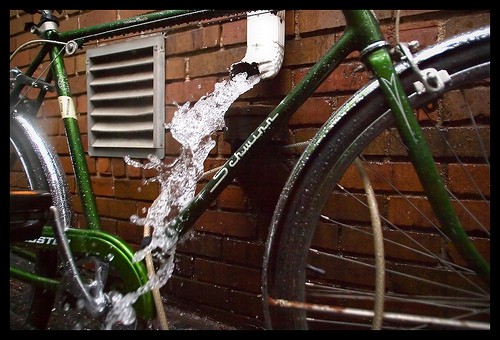
There are endless benefits to commuting on two wheels: exercise, endorphins, energy-efficiency, self-fulfilment, etc. Most people love their morning ride for the fresh air and great views, but sooner or later everyone finds that they have to start riding at night, or worse, through the rain. Scary as it may be, knowledge, equipment, and skill make it a lot easier to be confident.
NIGHT RIDING
Lights: In addition to helping light your way, bike lights are necessary so that other people (namely, car drivers) can see you against the glare of automobile headlights. All state laws mandate a headlight at night, so just get one. (A white headlight identifies the fronts of all vehicles.)
What are my options?
1. Small battery lights: Best for riding under streetlights.
2. Generator systems: Bright enough for lighting dark roads. Good for long-distance touring, but most lights will turn off when you’re not riding which is inconvenient for stop-and-go city commutes. (Some generators have battery backup that keeps them lighted when you stop.)
 3. High-powered battery systems: Brightest light but also most expensive and generally heavier than other lights. Good for dark roads or trails.
3. High-powered battery systems: Brightest light but also most expensive and generally heavier than other lights. Good for dark roads or trails.
TIP: Carry spare bulbs/batteries for your lights.
Reflectors: Rear reflector and pedal reflectors are especially important for night riding. They signal drivers behind you and work even if your main lights go out.
TIP : Flash your headlight at drivers to catch their attention and make eye contact. This is important to get the attention of drivers pulling out of a side street.
RIDING THROUGH RAIN
Equipment:
1. Bicyclist’s Rain Cape: Similar to a poncho, but tailored for the bicyclist’s riding position. It has loops at the front to hook over your thumbs or the brake levers. A waist strap holds down the back of the cape. Brightly colored capes make you more visible to drivers. The rain cape is better than regular raincoats or ponchos because they allow ventilation.
2. Fenders: You’ll need a pair to use with your rain cape. They keep dirty water and mud from flying up under the cape.
3. Dry Rim Brakes: Steel rims are difficult in the rain–stopping distances may be increased by 10 times. Apply the brakes in advance, well before you need to stop.
TIP: Relubricate your bike chain after riding in the rain to help prevent it from rust.
Photo Credits: blhphotography, Wha’ppen, d. FUKA
